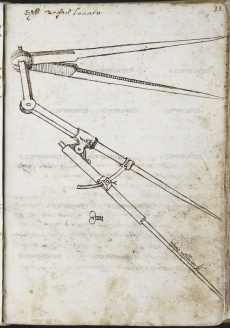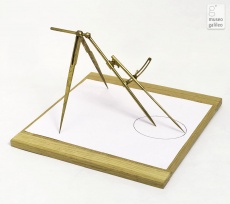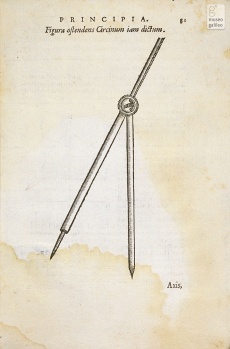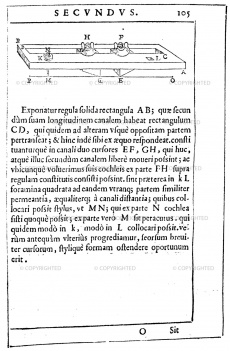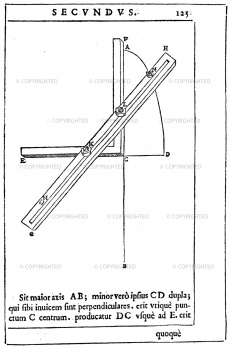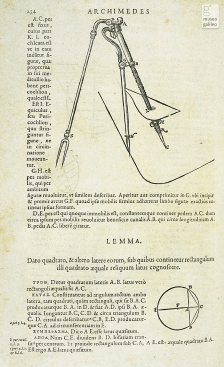Elliptical Compasses
From Inventions
| Line 51: | Line 51: | ||
Image: 8528_3202_1721-059.jpg |Giovanni Battista Benedetti. ''De gnomonum vmbrarumq[ue] solarium vsu liber ... : nunc primùm publicae vtilitati studiosorumq[ue] commoditati in lucem aeditus''. Torino, 1574, p.117r.<br /> | Image: 8528_3202_1721-059.jpg |Giovanni Battista Benedetti. ''De gnomonum vmbrarumq[ue] solarium vsu liber ... : nunc primùm publicae vtilitati studiosorumq[ue] commoditati in lucem aeditus''. Torino, 1574, p.117r.<br /> | ||
| - | |||
| - | |||
| - | |||
</gallery> | </gallery> | ||
Revision as of 08:32, 26 July 2010
Name used since the sixteenth century.
Contents |
Inventor
Arab anonym
Historic Period
X century
Description
Compass for drawing ellipses. Documented already in Arab mathematical tradition under the name of perfect compass, the instrument was illustrated in the sixteenth century by Benvenuto della Volpaia (who attributes its invention to Leonardo), Albrecht Dürer, Guidobaldo del Monte and other mathematicians. It generally consists of an inclined fixed leg representing the axis of a cone, and a revolving leg of variable length representing the generatrix. Turning around the inclined leg, the point of the revolving leg traces an elliptical curve on a sheet of paper. A variant designed to trace an ellipse as the oblique section of a cylinder is illustrated in a manuscript by the Venetian Senator Giacomo Contarini, who may have invented it.
Bibliographical Resources
Della Volpaia, Benvenuto, Macchine e strumenti, ms., XVI secolo, Venezia, Biblioteca Marciana, It. IV, 41 (= 5363), c. 18 r: “Seste da far l’ovato”.
Siena, Biblioteca degli Intronati, Ms. L.IV.10, c. 93.
Siena, Biblioteca degli Intronati, Ms. S.IV.6, c. 65v.
Benedetti, Giovanni Battista, Diversarum speculationum mathematicarum et phisicarum liber, Torino, 1585, pp. 325-327.
Besson, Jacques, Theatrum instrumentorum et machinarum, Lione, 1578, Figura V.
Del Monte, Guidobaldo, Planisphaeriorum universalium theorica, Pesaro, 1579, pp. 105, 125.
Barozzi, Francesco, Admirandum Illud Geometricum Problema, Venezia, 1586, pp. 30-31.
Contarini, Jacopo, Figure d'Istromenti Matematici e loro uso, ms., ca. 1590, Oxford, Bodleian Library, Ms. Canon. Ital. 145, cc. 9-13.
Bonino, Marco, ms., ca. 1580, Los Angeles, University of California, Ms 170/358, c. 12v.
Scheiner, Christoph, Exegeses Fundamentorum Gnomonicorum, Ingolstadt, 1615, p. 64.
Oddi, Muzio, Degli Horologi solari, Venezia, 1638, pp. 183 sgg.
Existing Instruments
Chicago, Adler Planetarium, Mensing 101.
Dresden, Staatlicher Mathemat.-Physikaliscer Salon, A.I.13.
Firenze, Museo Galileo. Istituto di Storia della Scienza, inv. 597.
Firenze, Museo Galileo. Istituto di Storia della Scienza, inv. 2542.
Norimberga, Germanisches Nationalmuseum, WI 1801, compasso di Christoph Schissler.
Images
Francesco Barozzi. Admirandum illud geometricum problema tredecim modis demonstratum : quod docet duas lineas in eodem plano designare, quae nunquam inuicem coincidant, etiam si in infinitum protrahantur & quantò longiùs producuntur, tantò sibiinuicem propiores euadant / Francisco Barocio ... autore ; accessit etiam instrumentum quoddam olim ab eodem autore inuentum, quo cuiuslibet coni ortus ac trium conicarum sect, Venetiis, 1586, p.31. |
||
Author of the entry: Filippo Camerota
